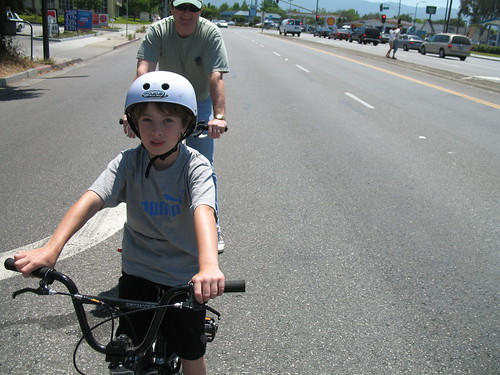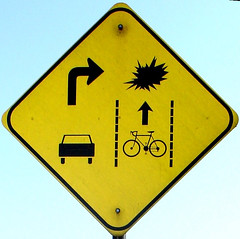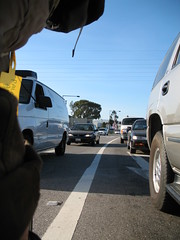The Times article notes that bike lanes can increase the hazard to cyclists by creating a false sense of security for the cyclist.
I can't agree with the suggestion in the article that urban cyclists stay alive by assuming we're "invisible to all drivers" and to "ride paranoid." If I want to be invisible, I'll ride in the bike lane -- I ride to be visible by positioning myself in the traffic when necessary and by signaling my intentions. My last collision (and my first in over a decade) occurred when I was hooked last fall while I was invisible in the bike lane. I ride defensively, but I believe that's different from riding as if I'm invisible or paranoid. For the most part, motorists are not out to get me, if only to avoid the inconvenience of a police report and insurance claim on their part. (Incidentally, for the snarky straw man idiots in the A&S forum over at BikeForums.net, positioning myself to be seen and for destination does not mean blocking whole lines of traffic behind me also).
Cyclists in California are taught to leave the bike lane or the right turn lane and position themselves for their direction of travel. The California Driver Handbook says this regarding bike lanes:
When you are making a right turn and are within 200 feet of the corner or other driveway entrance, you must enter the bike lane for the turn. Do not drive in the bike lane at any other time.I should note that motorists are required to merge into the bike lane only if the lane is clear, the same as if they're merging right into a regular traffic lane. If everybody actually followed this rule, we'd cut down substantially on the number of right hooks.
Before anybody complains that "this is too hard", let me direct you to the photo below showing a ten year old boy to the left of a right turn lane on busy Saratoga Avenue at I-280 in San Jose, California. The photo doesn't show it (I wouldn't have snapped the photo when the traffic was heavy), but moments after the photo was snapped traffic caught up from the intersection behind us and passed us on the right and the left. The right turn lane in the photo is access to an Interstate Highway on ramp. The Santa Clara County bike map labels this intersection "extreme caution" because of the heavy and fast traffic.

Of course, the California "solution" is not a panacea -- there are still idiot drivers and even (dare I write it?) idiot cyclists. Here's a dramatic video from the San Francisco Bicycle Coalition showing a cyclist getting hooked at speed by a driver making an illegal right turn from Market onto Octavia up in San Francisco.
The solution? I believe increased education for both motorists and cyclists on the hazard of right hook can help. Awareness through general media outlets like the Seattle Times article is good. Oh, and it's a "left cross," not a left hook. See Bicycle Safe for other types of common bike collisions and how to avoid them.
Please be sure to hit the Digg, del.icio.us and CycleCluster buttons below if you think this article is worth sharing. Thanks!



Buried in these forum comments are key reasons for the continuing problems between cyclists and motorized vehicles in the USA. In the section "do cyclists face the same problems in Europe" are these comments:
ReplyDelete1) The most important thing about Europe is the culture and attitude towards cyclists.
2) is that the countries with the strictest driver's licensing laws and rules of the road (Germany, Austria, etc.) have the highest levels of bicycling, whereas those with more lenient licensing and arguably greater anarchy on the road (southern Europe, U.S.) have significantly lower levels of bicycling
3) Cyclists actually have a wonderful dedicated network of paths...
4) Motorists are petrified of hitting a cyclist.
All too true.
Jack
...anon 11:54am...re: (4) motorists are petrified of hitting a cyclist...
ReplyDelete...that's a true statement basically because while no one wants to accidentally take a life, most motorists just don't wanna deal w/ the ensuing hassle...we are a 'problem' best swept under the rug...there is no pro-active thought regarding the fact that bicycles are a valid form of transportation & should be regarded as such 'on the road'...
...while yes, there are a lot of clueless, inconsiderate cyclists out there who contribute to the negative image of cycling, most non cyclists in vehicles, don't think about cyclists or want to think about cyclists until we are 'in their way'...
...i may sound like a broken record on this but every motorist will encounter cyclists at some point of their day for the rest of their lives & maybe that needs to be pro-actively recognized or addressed...
Sadly this whole situation goes beyond visibility of cyclists. I've been right hooked numerous times on my bike, and have been fortunate enough to miss hitting the car every time but one. Then a few months ago, I almost hit a car that right hooked me while I was DRIVING! I was in the right right lane, and without looking or signaling, the other driver tried to turn right onto a side street from the left lane. Some people get into a car and just become completely oblivious to all other road users.
ReplyDelete